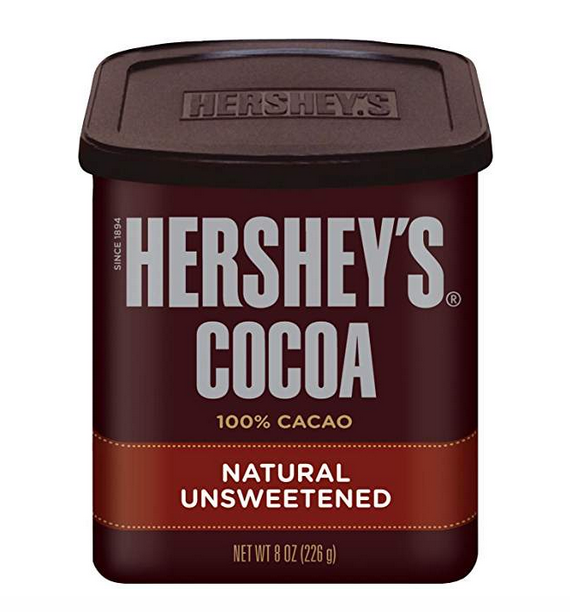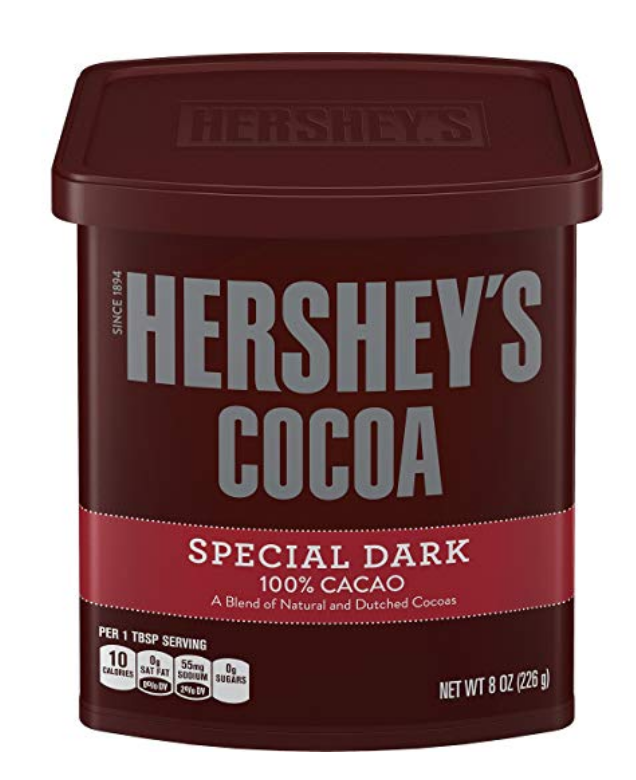BLOG
|
|
Screen shots of two products demonstrate confusing labels. 'Natural' cocoa powder provides far more anti-oxidant/anti-inflammatory power than 'Special Dark" powder subjected to alkali-processing (Dutching). FIGHTING INFLAMMATION In her article “11 Health and Nutrition Benefits of Cocoa Powder” for healthline.com, author Elise Mandel explains a number of positive effects that scientific studies indicate may be obtained from this substance.
The protective benefits of cocoa powder that Mandel details are many and include improving the health and functioning of blood vessels (vascular system), brain (central nervous system), and skin (integumentary system), management of body weight and blood glucose (metabolism), and protection against cancer (immune system). An article by David L Katz of Yale University and colleagues provided much of the information for this post as well as other articles with links embedded and identified below. WHAT IT IS: Cocoa powder is made from cocoa liquor, the basic paste created by the grinding of roasted and shelled cocoa beans that have first been fully fermented and dried. Cocoa liquor consists of non-fat cocoa solids (NFCS) plus cocoa butter. The quoted “percent cacao” of a food product on packaging is determined by the amount of cocoa liquor it contains. Thus, it is the percent cocoa liquor (mostly % NFCS) in a product that determines how “dark” it is in terms of its nutritional benefit, not the deepness of its color! Cocoa powder is produced by the removal of some of the cocoa butter from cocoa liquor. Chocolate is a solid food made by adding sugar and more cocoa butter to cocoa liquor.
Cocoa powder treated with an alkali-wash process known as “Dutching” has a dark brown appearance and is often labeled as “dark” cocoa. However, although untreated ‘natural’ cocoa powder is a lighter reddish-brown color, it has not undergone Dutch-processing and contains many more healthy anti-oxidant compounds (read discussion below) than the Dutch-processed darker-colored powder! An important difference between and cocoa powder and chocolate is fat content and caloric value. Recall that cocoa powder is cocoa liquor minus most, but not all, of its cocoa butter. Chocolate, on the other hand, contains all of the cocoa butter of cocoa liquor plus additional cocoa butter and sugar too! The higher fat and sugar content of calorie-dense chocolate raises concerns among nutritionists who do not wish to recommend solid chocolate as a health food, because eating more than small amounts each day may increase the risk of weight gain. Even scientists admit that chocolate craving is real. Cocoa powder may or may not induce craving in spite of its slight bitterness, but without the addition of high calorie ingredients to increase palatability it can be an obesity-safe nutritional supplement. Which brings us back to the topic of the numerous proposed health benefits of cocoa powder. HEALTH BENEFITS It contains biologically active compounds which include vitamins, minerals (high in magnesium, copper, and iron), some fiber, and other chemicals called polyphenols. Polyphenols are the health-boosting, plant-derived compounds found in fruits and vegetables that are responsible for their health benefits and, often times, their attractive bright colors. Flavanols are one type of polyphenol. The main flavanols identified in cocoa are epicatechin, catechin, and procyanidins. The Known Benefits of Cocoa Result from a Few Basic Mechanisms of Action. Each of the body systems, discussed above and identified in health articles like Mandel’s, that may be helped by the additional intake of cocoa in cocoa powder, are likely affected through a handful of physiological mechanisms that include:
Summary Benefits: the downstream effects of the biologically active components of cocoa include improving blood flow to body tissues and organs and dampening of the damaging effects of inflammation and oxidation which can lead to the initiation or worsening of chronic diseases. WHY CONSUME COCOA POWDER? The amounts of beneficial polyphenols in cocoa powder are the highest of all foods!
It’s anti-oxidant capacity lasts longer! Foods with significant free-radical scavenging, anti-oxidant activities like green tea, have been known to lose activity over time.
Caution: mixing cocoa powder with sugar is likely to decrease its anti-oxidant punch. Some studies suggest adding milk may have the same effect, but others have not demonstrated this result. HOW MUCH COCOA POWDER IS RECOMMENDED TO OBTAIN HEALTH BENEFITS? There is not a good answer, yet. A 2006 study of 470 older Dutch men without cardiovascular disease found “significantly lower cardiovascular and all-cause mortality”, about 50% less, in the group that consumed the most cocoa (more than 2.30gm/day) compared with the group that reported the least intake (.36 gm/day). Another 6-week study by the Yale-Griffin Prevention Research Center in Connecticut showed that men who drank 2 daily cups of a cocoa powder beverage containing 805mg flavanols (22gm cocoa powder) compared with placebo (0mg) demonstrated improved endothelial function. Improvement was noted when the cocoa was both unsweetened and sweetened, but the effect was less when sugar was added. A 2010 article published in the Indian Journal of Science and Technology “A Comparative Phytochemical Analysis of Cocoa and Green Tea” used 2 tablespoons cocoa powder as a serving. Each cocoa powder serving, when compared with a serving of green tea, was determined to contain more total phenols/epicatechin (550 versus 168.8) and total flavonoids (566 versus 353). The amounts of epigallocatechin gallate (EGCG) in each were 140.16 in cocoa versus 104.4mg in tea, per serving). A “massive” COSMOS study by Harvard Health is now underway, looking to obtain information that may help determine this and other details when it comes to prescribing cocoa flavanols for protection again “everything from heart disease, to stroke, to dementia”. Researchers at Harvard and Brigham and Women’s Hospital leading COSMOS (COcoa Supplement and Multivitamin Outcome Study), featured in a 2017 piece in The Harvard Gazette by Kai-Jae Wang, “are launching a four-year, 18,000-person, randomized trial to get at some of the truths behind the potential health benefits of cocoa”. The study is testing the effect of a daily 600mg supplement of cocoa flavanols (not chocolate they are careful to point out) over 4 years. [If one gram of cocoa powder contains about 50mg of polyphenols, which include flavanols, approximately 12grams would contain 600mg polyphenols. This amount is roughly 2.5 tablespoons by my measurement. The reference amount of a serving of specific chocolate and cocoa products customarily consumed, established by the United States Food and Drug Administration, is 5gm for cocoa powders both natural and Dutched, about 1 tablespoon by my measurement. FYI: a serving of baking chips or unsweetened chocolate is 15 gm, and of dark or milk chocolate is 40gm. The powders have the lowest fat content and highest percent NFCS of the different products. Dark chocolate has 3 times as much fat and 75% less NFCS as cocoa powder.] DOES COCOA POWDER BRAND MATTER? The amounts of antioxidants will vary in different cocoa powder brands, as determined by the amount of non-fat cocoa solids (NFCS) they contain. Among commercially available products in the US, the variation wasn’t found to be significant in a 2006 study analysis in which Hershey Company participated. Except for the Dutching process, “differences in cocoa bean blends and processing” were thought to be “minor factors in determining the level of antioxidants” in non-fat cocoa solid (NFCS) products. In a 2006 study in which Hershey Company did not participate, three de-identified* brands of cocoa powder were tested for percent NFCS (CP-1 = 85.2%, CP-2 = 72.2%, and CP-3 = 87.3%), anti-oxidant capacity (875, 720, and 816 umol Trolox Equivalents/g ORAC rating), total polyphenols (~60, 45, and 51 mg/g gallic acid equivalents), and total procyanidins (~23. 19, and 22mg/g). All tested properties were at the highest level in the 3 cocoa powder brands analyzed, compared with other products (chocolate syrup, milk chocolate, semi-sweet chocolate chips, dark chocolate, and baking chocolate). WHY MIGHT COCOA POWDER HELP ATHLETES? In addition to the obvious cardiovascular and anti-cancer benefits purported to be gained from cocoa powder, how might we be helped? Joints: One of the anti-inflammatory components identified in cocoa powder is epigallocatechin gallate (EGCG). This polyphenol, which is also found in green tea, has been studied with green tea extract for its effect on osteoarthritis (OA). The evidence suggests EGCG may be able to reduce tissue damage associated with OA including “synovial hyperplasia, cartilage degradation, and bone resorption by modulating multiple targets in joints during the development of OA”.
Skin: Outdoor exercisers are exposed regularly to skin damaging UV light, a risk factor for common skin cancers. Although we all mean to re-apply sunscreen as recommended for protection, there are bound to be minutes and hours when coverage is less than optimal.
In Earned Runs opinion, natural cocoa powder represents a stable, convenient, relatively low-cost and low-calorie supplement with the highest values of anti-oxidant and anti-inflammatory compounds found in foods, which promises to deliver protection against a number of chronic diseases. It can be used to make a pleasant, although slightly bitter drink. Adding a beverage or two to the diet on most days, without also adding sugar or milk, may provide health benefits that otherwise would require the intake of much larger quantities of higher calorie food products. With the Harvard Health COSMOS study in process, there may be more information revealed within several years with regard to specific ‘dosages’ of crucial bioactive compounds required to generate a positive health effect. I In the meantime, a tablespoon of natural cocoa powder dissolved in hot water may be an appealing tonic to some. In the summer heat, poured over ice, it can be a cool, healthy, less expensive treat to substitute for a higher-calorie sweet coffee or tea concoction. RUN & MOVE HAPPY! *Ghiradelli, Hershey’s, Nestle Toll House https://www.healthline.com/nutrition/cocoa-powder-nutrition-benefits David L. Katz. Kim Doughty, Ather Ali. “COMPREHENSIVE INVITED REVIEW “Cocoa and Chocolate in Human Health and Disease” https://www.ncbi.nlm.nih.gov/pmc/articles/PMC4696435/ https://www.ncbi.nlm.nih.gov/pmc/articles/PMC4696435/pdf/ars.2010.3697.pdf https://yalegriffinprc.griffinhealth.org/research/completed-projects?udt_1588_param_detail=1865 http://www.indjst.org/index.php/indjst/article/viewFile/29676/25650 https://news.harvard.edu/gazette/story/2017/02/cocoa-for-pleasure-and-health/ https://pubs.acs.org/doi/abs/10.1021/jf060360r https://pubs.acs.org/doi/abs/10.1021/jf060290o https://www.thespruceeats.com/what-is-cocoa-powder-520351 https://www.livestrong.com/article/479645-polyphenols-vs-flavonoids/ https://en.wikipedia.org/wiki/Flavan-3-ol https://www.ncbi.nlm.nih.gov/pmc/articles/PMC4696435/ https://blog.healthkismet.com/2013/03/22/high-orac-superfoods-green-tea-vs-cocoa/ https://academic.oup.com/ajcn/article/81/1/298S/4607596 https://en.wikipedia.org/wiki/Flavan-3-ol
0 Comments
Your comment will be posted after it is approved.
Leave a Reply. |
BRIDGE TO PHYSICAL SELF
Running, walking, and fitness activities enable us to experience our physical selves in a world mostly accessed through use of fingers on a mobile device. AuthorEARNED RUNS is edited and authored by me, runner and founder. In 1978 I began participating in 10K road races before 5Ks were common. I've been a dietitian, practiced and taught clinical pathology, and been involved with research that utilized pathology. I am fascinated with understanding the origins of disease as well as health and longevity. Archives
November 2023
CategoriesNew! Search Box
Earned Runs is now searchable! Check it out...
|



 RSS Feed
RSS Feed